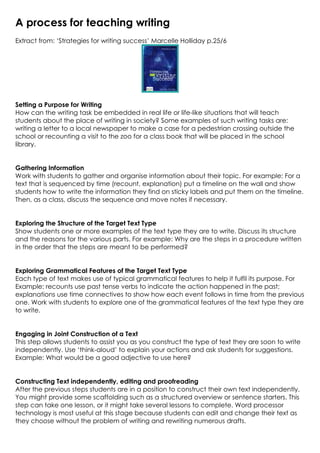
A process for teaching writing
- 1. A process for teaching writing Extract from: ‘Strategies for writing success’ Marcelle Holliday p.25/6 Setting a Purpose for Writing How can the writing task be embedded in real life or life-like situations that will teach students about the place of writing in society? Some examples of such writing tasks are: writing a letter to a local newspaper to make a case for a pedestrian crossing outside the school or recounting a visit to the zoo for a class book that will be placed in the school library. Gathering Information Work with students to gather and organise information about their topic. For example: For a text that is sequenced by time (recount, explanation) put a timeline on the wall and show students how to write the information they find on sticky labels and put them on the timeline. Then, as a class, discuss the sequence and move notes if necessary. Exploring the Structure of the Target Text Type Show students one or more examples of the text type they are to write. Discuss its structure and the reasons for the various parts. For example: Why are the steps in a procedure written in the order that the steps are meant to be performed? Exploring Grammatical Features of the Target Text Type Each type of text makes use of typical grammatical features to help it fulfil its purpose. For Example: recounts use past tense verbs to indicate the action happened in the past; explanations use time connectives to show how each event follows in time from the previous one. Work with students to explore one of the grammatical features of the text type they are to write. Engaging in Joint Construction of a Text This step allows students to assist you as you construct the type of text they are soon to write independently. Use ‘think-aloud’ to explain your actions and ask students for suggestions. Example: What would be a good adjective to use here? Constructing Text independently, editing and proofreading After the previous steps students are in a position to construct their own text independently. You might provide some scaffolding such as a structured overview or sentence starters. This step can take one lesson, or it might take several lessons to complete. Word processor technology is most useful at this stage because students can edit and change their text as they choose without the problem of writing and rewriting numerous drafts.
- 2. Using the Students’ Texts Find a way to use the texts the students have written for a real life or life-like purpose. You might want to link your teaching unit into a community event or issue and arrange for your students to display their writing on a community noticeboard or have a letter printed in a local paper. Assessing writing Assessment provides the best guide to what your students already know and can do with their writing. Assessment gives a clear starting point for programming and teaching, and helps you to decide what features of the selected text type to focus on and what support to provide so that students will achieve success.
